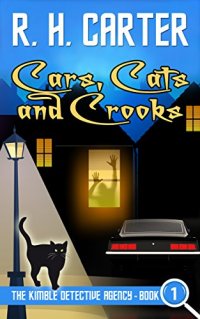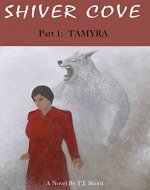Independent female sleuths, not just sidekicks, have been around since the start of the genre, pre-dating the appearance of female police detectives in real life: Susan Hopley was solving crimes in 1841, fifteen years before Kate Warne would join the Pinkertons, and the literary Mrs Gladden was busy in 1864, while the first woman didnтАЩt join the London Met until 1923. However there is one particular type of female sleuths which has been cropping up more and more recently in indie books: the divorced or widowed detective, with pet cat.
If you widen the criteria a little, the trend becomes even more obvious as a range of books across various genres suddenly fall into this type. It need not always be divorced or widowed ladies with pet cats: for example, in Southern Spirits, Verity left her fianc├йe at the altar and has a pet skunk. Hence a more correct name for the type of book IтАЩm exploring today would probably be тАЬNewly-unattached with pet: Mystery wantedтАЭ.
Before starting, IтАЩm excluding the Petectives and other talking animal series like the Magical Cool Cats from this article. While pets running their own detective agency solving other animalтАЩs problems is amusing, it is a very different genre. This piece is about human sleuths with realistic animal companions who are a large part of the sleuthтАЩs life and mysteries.
The role the pet, usually a cat, plays in the mystery varies. In the Counterfeiter-Catching Cat, the divorced Beatrice is nearly second fiddle to her downright naughty Maine Coon, who steals evidence (and iPhones). In Frances EveshamтАЩs Murder at the Lighthouse, Libby is widowed, and runs a dog-walking business. Even Lizz LundтАЩs Mina Kitchen has a cat, although Vinnie is more likely to be a problem than solve them. There are many other examples coming out that havenтАЩt crossed our desks for review yet, like тАЬLong Paw of the LawтАЭ or тАЬCats, Cakes, and CluesтАЭ but this article is going to focus on the ones weтАЩve read.
Whether divorced, widowed, dumped or dumper, the sleuth is usually single and in most often they are fresh from a relationship (Beatrice, a long-term divorcee is a partial exception). Why so many authors like their characters unattached part is easy to explain: it means the detective is free to investigate cases and take risks without problems or endangering others. The lack of children is probably for similar reasons as, particularly in the cozy mystery genre, people do not like reading about children in danger and if they are present the author would need to find excuses to keep them out of the way. As with male sleuths it leaves the character open to take risks, have a succession of love interests, and gives them freedom to investigate.
So if they are foot-loose and fancy-free, why the pet? Apart from a Sherlock Homes clone who was obsessive about his goldfish, very few male amateur sleuths seem to have a pet that plays as great a part in the mystery (if they have any pets aside from their ubiquitous junior sidekick). They might solve cases about them, but normally they arenтАЩt part of their life.
This is where critics could froth about the expectation of women to be nurturing, the stereotype of the crazy cat lady, or the belief that the sleuth must be using the pet as a child substitute (although good parents donтАЩt attach cameras to their childrenтАЩs collars and then send them to crawl under cars to record the gangstersтАЩ meeting). This interpretation seems unlikely to be correct however, as the pets usually serve a far more distinct plot purpose.
In some cases a pet can serve as the audience stand-in. The detective can talk to her pet about the case, letting the reader follow their thought process: a furry Watson if you will. ItтАЩs a simple conceit, which avoids the author having their character talking to themselves, or explaining things to people who already know them. In the absence of the inexperienced or dense sidekick, a pet can be quite a useful literary device. For character purposes, no matter how rough or tough the detective, if they melt over their pet at home it is easy to sympathise without making them look weak in front of others.
In other cases they serve as a critical part of the plot, discovering evidence or even dragging the main character into the mystery. Dogs discovering bodies in woodlands is a regular real-life event in many newspapers, so it makes an easy and believable lead in. A dog as a pet can also solve the Miss Marple problem: what happens when a violent murderer decides to take a Gordian solution to the issue of removing that annoying elderly sleuth? In one story an otherwise uninvolved mastiff makes quite an effective bodyguard when a suspect tries to eliminate the sleuth.
And finally? Pet stories draw readers. Since we are talking about ebooks here it is worth remembering that cats have a certain degree of popularity on the internet (e, g, Lolcats, Catscan, most of TwitterтАж) and ebooks are ordered online. While cats may not be added just as an audience grab, they can certainly work as one!
So why the trend and sudden popularity? It might be something to do with the demographics of e-reader owners: predominantly female, with a preference for romance. An unattached heroine offers possibilities for romance, and a pet gives her a grounding and some responsibility. It makes them easy to relate to, someone who the reader can imagine chatting to about the case over coffee, and is easy to put themselves in the place of.
So why the sudden spread of them? Again it may partly be due to self-publishing. While publishers saw the value in the genre and have had independent female sleuths for years, they did not want to release too many similar titles to avoid competing with their own titles. James HerriotтАЩs biography states that his books nearly werenтАЩt published because the publisher already had a тАШvetтАЩ series. With self-publishing, that restriction is removed, so many similar books can come out. When an author sees something similar they might brush off a title from their hard-drive and put it up.
There probably isnтАЩt a danger of running out of readers because these are cozy mysteries, often with romance overtones, and romance sells. Romance readers read a lotтАКтАФтАКso much so that in 2015 Scribd excluded romance from its тАЬAll you can readтАЭ membership deal because it cost too much to pay for all the books! This means that the support for this type of story may well be around for quite some time and, although authors may come and go, the good ones have an excellent chance of finding an ongoing audience. If it carries on for a few more years, this could be more than a fad.
And personally we think more cats in books is a good thing!










